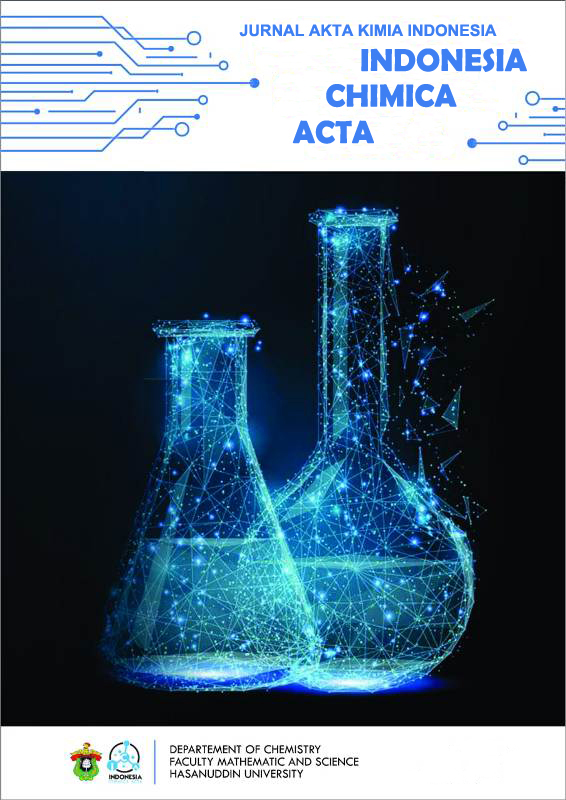Main Article Content
Abstract
Keywords
Article Details
References
- Anjum, S. and Abbasi, B. H., 2016, Thidiazuron-Enhanced Biosynthesis And Antimicrobial Efficacy Of Silver Nanoparticles Via Improving Phytochemical Reducing Potential In Callus Culture Of Linum usitatissimum L., International Journal of Nanomedicine, 11 (2016): 715–728.
- Apriandanu, D., Wahyuni, S., Hadisaputro, S. and Harjono, 2013, Synthesis of Silver Nanoparticles Using the Polyol Method with Polyinilalkohol Stabilizing Agent (PVA), Journal of Mathematics and Natural Sciences, 36 (2): 157-168.
- Desmiaty, Y., Puspitasari, A. and Zuhri, UM, 2015, Test of Xanthine Oxidase Inhibition Activity and Determination of Quercetin Levels Guava Leaf Extract (Psidium guajava L.) and Daun Beluntas (Pluchea indica Less.)., Published at the National Pharmacy University Seminar Jenderal Achmad Yani, Bandung.
- Desna, M. L., Wellia, D. V. and Arief, S., 2015, Control of the Formation of Silver Nanoparticles through Capping Agents with the Aid of Bioreductor Gambir Leaf Extract (Uncaria gambir Roxb), Journal of Chemistry Unand, 4 (2): 18-22.
- Fabiani, V. A., Sutanti, F., Silvia, D. and Putri, M. A., 2018, Green Synthesis Silver Nanoparticles Using Pucuk Idat Leaf Extract (Cratoxylum glaucum) as Bioreductor, Indo. J.Pure App. Chem., 1 (2): 68-76.
- Kumar, H. and Rani, R., 2013, Structural Characterization of Silver Nanoparticles Synthesized by Micro emulsion Route, International Journal of Engineering and Innovative Technology (IJEIT), 3 (3): 344-348.
- Shameli, K., Ahmad, M. B., Zamanian, A., Sangpour, P., Shabanzadeh, P., Abdollahi, Y. and Zargar, M., 2012, Green Biosynthesis of Silver Nanoparticles using Curcuma longa tuber powder, International Journal of Nanomedicine, 7 (2012): 5603–5610.
- Terenteva, E. A., Apyari, V. V., Dimitrienko, S. G. and Zolotov, Y. A., 2015, Formation of Plasmonic Silver Nanoparticles by Flavonoid reduction: A comparative Study and Application For Determination of These Substances, Spectrochimica Acta Part A, 151 (2015): 89-95.
- Wahab, A. W., Karim, A., Asmawati dan Sutapa, I. W., 2018, Bio-synthesis of Gold Nanoparticles Through Bioreduction Using the Aqueous Extract of Muntingia calabura L. Leaves, Oriental Journal Of Chemistry, 34 (1): 401-409.
- Widyawati, P. S., Wijaya, C. H., Hardjosworo, P. S. and Sajuthi D., 2008, Evaluation of Antioxidative Activity of Beluntas Leaf Extract (Pluchea Indica) Based on the Difference of Leaf Section, Faculty of Agricultural Technology - Unika Widya Mandala, Surabaya.
References
Anjum, S. and Abbasi, B. H., 2016, Thidiazuron-Enhanced Biosynthesis And Antimicrobial Efficacy Of Silver Nanoparticles Via Improving Phytochemical Reducing Potential In Callus Culture Of Linum usitatissimum L., International Journal of Nanomedicine, 11 (2016): 715–728.
Apriandanu, D., Wahyuni, S., Hadisaputro, S. and Harjono, 2013, Synthesis of Silver Nanoparticles Using the Polyol Method with Polyinilalkohol Stabilizing Agent (PVA), Journal of Mathematics and Natural Sciences, 36 (2): 157-168.
Desmiaty, Y., Puspitasari, A. and Zuhri, UM, 2015, Test of Xanthine Oxidase Inhibition Activity and Determination of Quercetin Levels Guava Leaf Extract (Psidium guajava L.) and Daun Beluntas (Pluchea indica Less.)., Published at the National Pharmacy University Seminar Jenderal Achmad Yani, Bandung.
Desna, M. L., Wellia, D. V. and Arief, S., 2015, Control of the Formation of Silver Nanoparticles through Capping Agents with the Aid of Bioreductor Gambir Leaf Extract (Uncaria gambir Roxb), Journal of Chemistry Unand, 4 (2): 18-22.
Fabiani, V. A., Sutanti, F., Silvia, D. and Putri, M. A., 2018, Green Synthesis Silver Nanoparticles Using Pucuk Idat Leaf Extract (Cratoxylum glaucum) as Bioreductor, Indo. J.Pure App. Chem., 1 (2): 68-76.
Kumar, H. and Rani, R., 2013, Structural Characterization of Silver Nanoparticles Synthesized by Micro emulsion Route, International Journal of Engineering and Innovative Technology (IJEIT), 3 (3): 344-348.
Shameli, K., Ahmad, M. B., Zamanian, A., Sangpour, P., Shabanzadeh, P., Abdollahi, Y. and Zargar, M., 2012, Green Biosynthesis of Silver Nanoparticles using Curcuma longa tuber powder, International Journal of Nanomedicine, 7 (2012): 5603–5610.
Terenteva, E. A., Apyari, V. V., Dimitrienko, S. G. and Zolotov, Y. A., 2015, Formation of Plasmonic Silver Nanoparticles by Flavonoid reduction: A comparative Study and Application For Determination of These Substances, Spectrochimica Acta Part A, 151 (2015): 89-95.
Wahab, A. W., Karim, A., Asmawati dan Sutapa, I. W., 2018, Bio-synthesis of Gold Nanoparticles Through Bioreduction Using the Aqueous Extract of Muntingia calabura L. Leaves, Oriental Journal Of Chemistry, 34 (1): 401-409.
Widyawati, P. S., Wijaya, C. H., Hardjosworo, P. S. and Sajuthi D., 2008, Evaluation of Antioxidative Activity of Beluntas Leaf Extract (Pluchea Indica) Based on the Difference of Leaf Section, Faculty of Agricultural Technology - Unika Widya Mandala, Surabaya.
